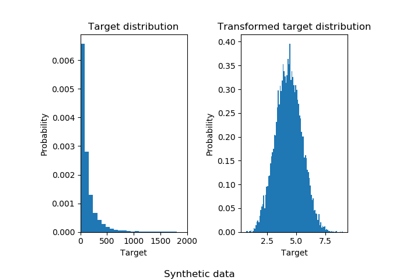sklearn.compose.TransformedTargetRegressor¶
-
class
sklearn.compose.TransformedTargetRegressor(regressor=None, transformer=None, func=None, inverse_func=None, check_inverse=True)[source]¶ Meta-estimator to regress on a transformed target.
Useful for applying a non-linear transformation to the target
yin regression problems. This transformation can be given as a Transformer such as the QuantileTransformer or as a function and its inverse such aslogandexp.The computation during
fitis:regressor.fit(X, func(y))
or:
regressor.fit(X, transformer.transform(y))
The computation during
predictis:inverse_func(regressor.predict(X))
or:
transformer.inverse_transform(regressor.predict(X))
Read more in the User Guide.
- Parameters
- regressorobject, default=LinearRegression()
Regressor object such as derived from
RegressorMixin. This regressor will automatically be cloned each time prior to fitting.- transformerobject, default=None
Estimator object such as derived from
TransformerMixin. Cannot be set at the same time asfuncandinverse_func. IftransformerisNoneas well asfuncandinverse_func, the transformer will be an identity transformer. Note that the transformer will be cloned during fitting. Also, the transformer is restrictingyto be a numpy array.- funcfunction, optional
Function to apply to
ybefore passing tofit. Cannot be set at the same time astransformer. The function needs to return a 2-dimensional array. IffuncisNone, the function used will be the identity function.- inverse_funcfunction, optional
Function to apply to the prediction of the regressor. Cannot be set at the same time as
transformeras well. The function needs to return a 2-dimensional array. The inverse function is used to return predictions to the same space of the original training labels.- check_inversebool, default=True
Whether to check that
transformfollowed byinverse_transformorfuncfollowed byinverse_funcleads to the original targets.
- Attributes
- regressor_object
Fitted regressor.
- transformer_object
Transformer used in
fitandpredict.
Notes
Internally, the target
yis always converted into a 2-dimensional array to be used by scikit-learn transformers. At the time of prediction, the output will be reshaped to a have the same number of dimensions asy.See examples/compose/plot_transformed_target.py.
Examples
>>> import numpy as np >>> from sklearn.linear_model import LinearRegression >>> from sklearn.compose import TransformedTargetRegressor >>> tt = TransformedTargetRegressor(regressor=LinearRegression(), ... func=np.log, inverse_func=np.exp) >>> X = np.arange(4).reshape(-1, 1) >>> y = np.exp(2 * X).ravel() >>> tt.fit(X, y) TransformedTargetRegressor(...) >>> tt.score(X, y) 1.0 >>> tt.regressor_.coef_ array([2.])
Methods
fit(self, X, y, \*\*fit_params)Fit the model according to the given training data.
get_params(self[, deep])Get parameters for this estimator.
predict(self, X)Predict using the base regressor, applying inverse.
score(self, X, y[, sample_weight])Return the coefficient of determination R^2 of the prediction.
set_params(self, \*\*params)Set the parameters of this estimator.
-
__init__(self, regressor=None, transformer=None, func=None, inverse_func=None, check_inverse=True)[source]¶ Initialize self. See help(type(self)) for accurate signature.
-
fit(self, X, y, **fit_params)[source]¶ Fit the model according to the given training data.
- Parameters
- X{array-like, sparse matrix}, shape (n_samples, n_features)
Training vector, where n_samples is the number of samples and n_features is the number of features.
- yarray-like, shape (n_samples,)
Target values.
- **fit_paramsdict of string -> object
Parameters passed to the
fitmethod of the underlying regressor.
- Returns
- selfobject
-
get_params(self, deep=True)[source]¶ Get parameters for this estimator.
- Parameters
- deepbool, default=True
If True, will return the parameters for this estimator and contained subobjects that are estimators.
- Returns
- paramsmapping of string to any
Parameter names mapped to their values.
-
predict(self, X)[source]¶ Predict using the base regressor, applying inverse.
The regressor is used to predict and the
inverse_funcorinverse_transformis applied before returning the prediction.- Parameters
- X{array-like, sparse matrix} of shape (n_samples, n_features)
Samples.
- Returns
- y_hatarray, shape = (n_samples,)
Predicted values.
-
score(self, X, y, sample_weight=None)[source]¶ Return the coefficient of determination R^2 of the prediction.
The coefficient R^2 is defined as (1 - u/v), where u is the residual sum of squares ((y_true - y_pred) ** 2).sum() and v is the total sum of squares ((y_true - y_true.mean()) ** 2).sum(). The best possible score is 1.0 and it can be negative (because the model can be arbitrarily worse). A constant model that always predicts the expected value of y, disregarding the input features, would get a R^2 score of 0.0.
- Parameters
- Xarray-like of shape (n_samples, n_features)
Test samples. For some estimators this may be a precomputed kernel matrix or a list of generic objects instead, shape = (n_samples, n_samples_fitted), where n_samples_fitted is the number of samples used in the fitting for the estimator.
- yarray-like of shape (n_samples,) or (n_samples, n_outputs)
True values for X.
- sample_weightarray-like of shape (n_samples,), default=None
Sample weights.
- Returns
- scorefloat
R^2 of self.predict(X) wrt. y.
Notes
The R2 score used when calling
scoreon a regressor will usemultioutput='uniform_average'from version 0.23 to keep consistent withr2_score. This will influence thescoremethod of all the multioutput regressors (except forMultiOutputRegressor). To specify the default value manually and avoid the warning, please either callr2_scoredirectly or make a custom scorer withmake_scorer(the built-in scorer'r2'usesmultioutput='uniform_average').
-
set_params(self, **params)[source]¶ Set the parameters of this estimator.
The method works on simple estimators as well as on nested objects (such as pipelines). The latter have parameters of the form
<component>__<parameter>so that it’s possible to update each component of a nested object.- Parameters
- **paramsdict
Estimator parameters.
- Returns
- selfobject
Estimator instance.

